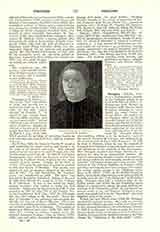

UNIVERSITY OF PERUGIA.—One of the “free” universities of Italy, was erected into a studium generale on September 8, 1308, by the Bull “Super specula” of Clement V. A school of arts existed about 1200, in which medicine and law were soon taught. Before 1300 there were several universitates scholiarum. Jacobus de Belviso, a famous civil jurist, taught here from 1316 to 1321. By Bull of August 1, 1318, John XXII granted the privilege of conferring degrees in civil and canon law, and on February 18, 1321, in medicine and arts.
On May 19, 1355, the Emperor Charles IV issued a Bull confirming the papal erection and raising it to the rank of an imperial university. This unusual mark of favor was given to assist Perugia after the terrible plague years 1348-49. In 1362 the Collegium Gregorianum (later called the Sapienza vecchia) was founded by Cardinal Nicolo Capocci for the maintenance of forty youths. Gregory XI by Brief of October 11, 1371 gave the privileges of a studium generale to this new faculty of theology. This faculty was suppressed and its property merged in the university in 1811. To this foundation the Sapienza nuova was transferred in 1829. The latter was founded by Benedetto Guidalotti, Bishop of Recanti in 1426, with Martin V’s approval, as the Collegio di S. Girolamo. It was a free hostel for impecunious strangers who wished to study law and medicine. Suppressed by the French in 1798, it was reopened in 1807 by Pius VII as the Collegio Pio. In the Constitution of August 27, 1824. Leo XII made this the chief college of the university. Since the time of Napoleon I the university has occupied the old Olivetan convent of Monte Morcino. There was a faculty of mathematics down to 1884. The statutes are modeled upon those of Bologna. The number of students at different dates were: 1339, 142; 1881, 79; 1911, 350. Among its eminent teachers were: the canonist Johannes Andreas; Cino da Pistoia (1270-1336), poet and jurist; his pupil Bartolus (1314-27), famous civil jurist; his pupil Baldus; Albericus Gentilis, founder of the science of international law; and Francesco della Rovere (Sixtus IV). Among its students were: Nicholas IV, Gregory XI, Innocent VII, Martin V, Pius III, Julius II, Julius III, Urban VII, Gregory XIV, Clement VIII, and Paul V.
Statistics (1911):—Expenditure, 295,470 lire; receipts, 285,748 lire; examination fees, 5948 lire; faculty of jurisprudence, 11 professors; faculty of medicine, 13; school of pharmacy 5; school of veterinary medicine, 3. A large number of institutions are connected with the university, e.g., an obstetric training college, laboratories for general chemistry and for pharmacy, etc., also the meteorological observatory (founded 1800). The library has over 54,000 volumes. The museum contains vases, bronzes, and sculptures, and many valuable Etruscan and Roman antiquities.
C. F. WEMYSS BROWN

